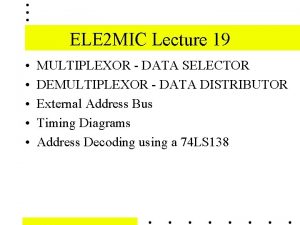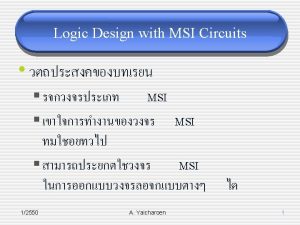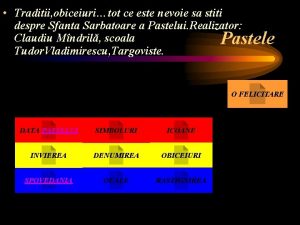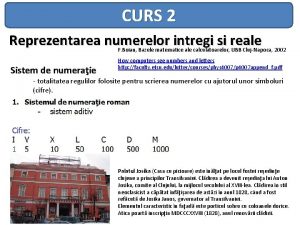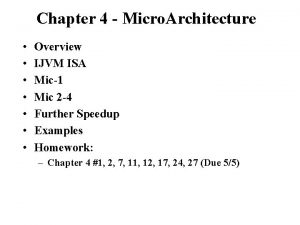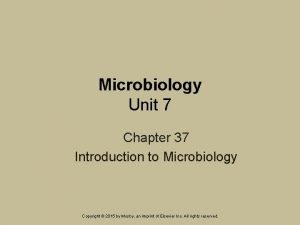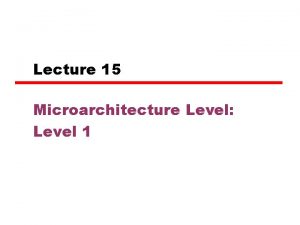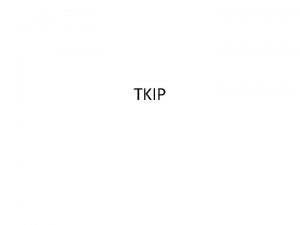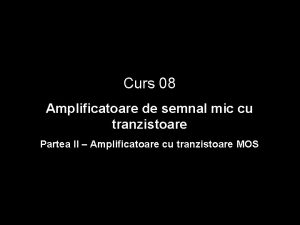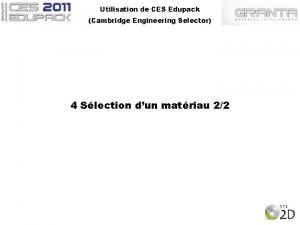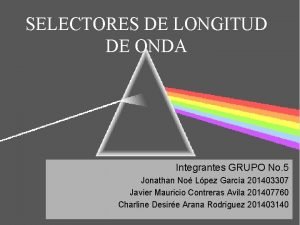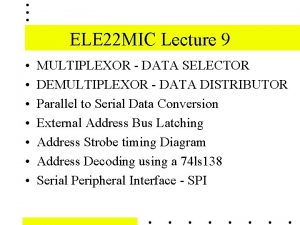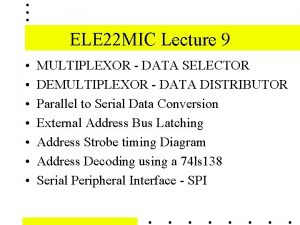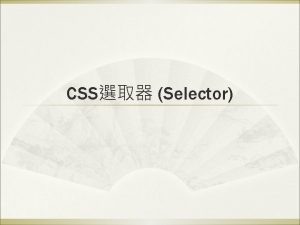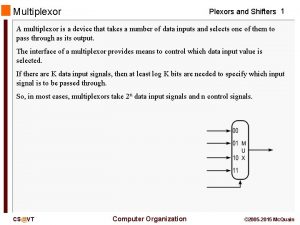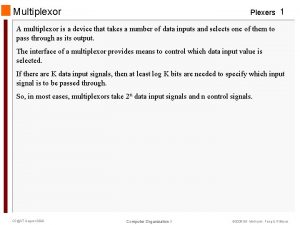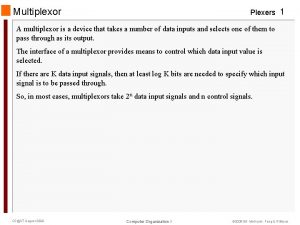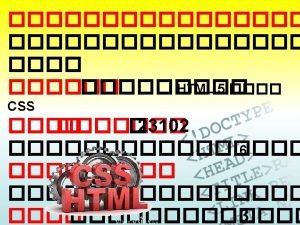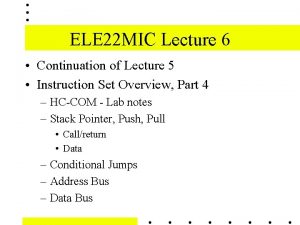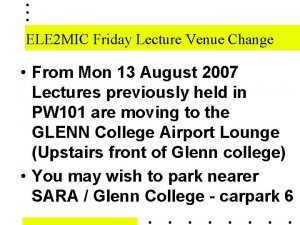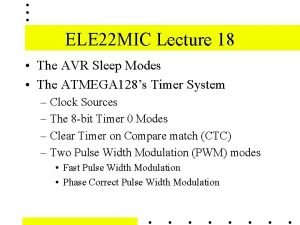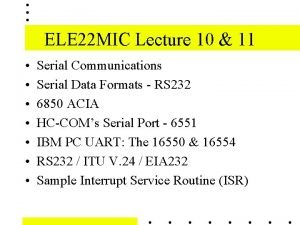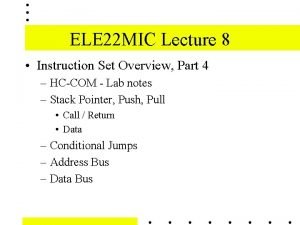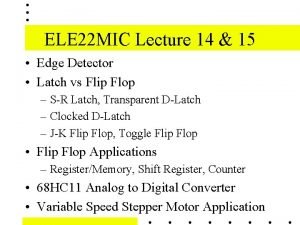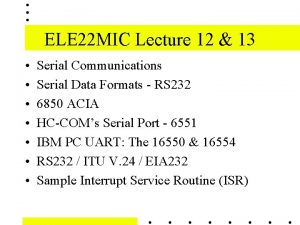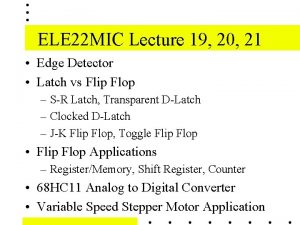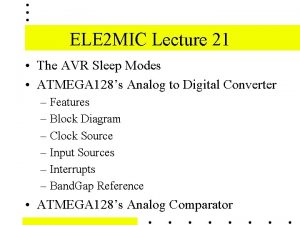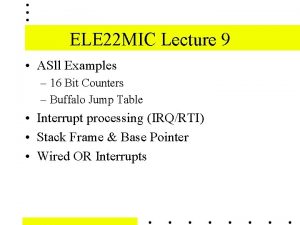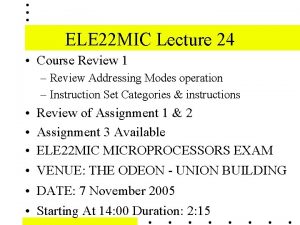ELE 2 MIC Lecture 19 MULTIPLEXOR DATA SELECTOR




































- Slides: 36

ELE 2 MIC Lecture 19 • • • MULTIPLEXOR - DATA SELECTOR DEMULTIPLEXOR - DATA DISTRIBUTOR External Address Bus Timing Diagrams Address Decoding using a 74 LS 138

Multiplexor - Data Selector • Multiplex (MUX) many inputs to one output • Switch selects the one signal source from many input signals. • Like Stereo Hi. Fi source selection switch

Two Input Multiplexor Output = (Input 0 & Select#) | (Input 1 & Select)

Four Input Multiplexor

Eight Input Multiplexor

74 F 151 8 -Input MUX

74 F 151 8 -Input MUX Pin Names and Loading / Fanout

Mux vs De. Mux

AVR On-Chip SRAM Timing

AVR Data Ram • When 4 KB is enough RAM for an application, the On-Chip SRAM is sufficient. • When 4 KB is insufficient, an external RAM chip can be used to expand the address range to 64 K bytes. • There are four memory configuration options for external RAM.

AVR External Data Ram • By setting the XMEM bit to 1, the e. Xternal MEMory interface is enabled, and the dedicated external memory control lines become active. • The dedicated controls are ALE#, RE#, WE# and the multiplexed address & data bus bits 0. . 7 and the address bits 8. . 15 take control, overriding the port A, port C and port G (pins 0. . 2) functions.

AVR External Data Ram • The dedicated control signals are: • RE# - Read Enable - Active Low – Data is read from the external memory (or device) into the AVR microcontroller. • WE# - Write Enable - Active Low – Data is written from the AVR to the external memory (or device).

AVR External Data Ram • ALE - Address Latch Enable - Active High. • When ALE transitions high, the Memory Address Register is asserted onto the Multiplexed Address & Data bus lines • the bus enters a write-address phase • the address is latched into an external address latch which is used to form an system’s external address bus.

AVR External Data Ram • ALE - Address Latch Enable - Active High. • When ALE is low, a data phase commences and data can be read or written to the external memory or device. • (external in this context refers to off-chip memory)

AVR External Address Latch

AVR External Mem Timing

AVR External Mem Timing

68 HC 11 External Address Latch

HC 11 Strobe Timing Diagram

Applications of a de-multiplexor • The Memory Chip Select device used on the original IBM PC is a 74 xx 138 de-multiplexor. • The 74 LS 138 is used to activate 1 of 8 lines based on the conditions of the three binary select inputs A, B & C, and the three enable inputs. • The 74 LS 138 Outputs are “Active Low”.

74 LS 138 8 -Output DEMUX De-Multiplex one input to many outputs -Reverse operation of a multiplexor 74 LS 138 Truth Table

De. Multiplexor • The 74 LS 138 can be implemented by the logic shown. • The 54 LS 138 is identical in function, but can operate over the “Mil-spec” -55°C to 125°C Temperature Range. • The 74 LS 138 can operate over the Commercial 0°C 70°C Temperature Range.

Memory Select

Address Decoding & Chip Select • • A 15 -> G 1#, E -> G, A 14 -> A 2, A 13 -> A 1 R/W# -> A 0 Chip is enabled when A 15 = 0 & E is High Y 2 = (A 14#) & (A 13) & Write (R/W#=0) & E Y 3 = (A 14#) & (A 13) & Read (R/W#=1) & E Y 4 = (A 14) & (A 13#) & Write (R/W#=0) & E Y 5 = (A 14) & (A 13#) & Read (R/W#=1) & E

Write Data Timing Diagram

EEPROM Technology (1)

EEPROM Technology (2) Erasure of Cells is performed by providing a tunnelling voltage to the control gate which causes the charge on the floating gate to be removed. When read, each cell returns a logical ‘ 1’ value.

EEPROM Technology (3) Programming of Cells is performed by providing a tunnelling voltage to the control gate which causes the charge to be placed on the floating gate. The write process writes the ‘ 0’s into each cell.



Logic Family - Propagation Delay (H-L)

Logic Family - Propagation Delay (L-H)

Logic Family - Propagation Delay (3)

Bus Design Rules Bus lines have very low line impedances (20. . 40 Ohms). • Bus lines have to be terminated to prevent line reflections (signal distortion, circuit malfunctions due to undershoots). • Take care of propagation times (25 ns/m). Settling time of signals on TTL-type buses is 2 x tp (no incident wave switching). • Take care of control lines (clock, read, write, etc. ). • Provide shielding between control lines and data / address lines.

Bus Design Rules • A multiplexed data and address bus reduces design problems (50% less signal lines and 50% less line drivers). • Driver output current is 100 m. A/line. Provide adequate and low inductance GND return path (simultaneous switching)! • Rule of thumb: 25% of all backplane connector pins have to be GND lines! • Use multilayer boards with separate GND and Vcc plane for backplanes.

Acknowledgements • Altium Protel 98, DXP or Altium 6 to create these schematic diagrams • Logic Timing Diagrams are from Texas Instruments (TI) Logic Selection Guide Digital Design Seminar • National Semiconductor data sheets 74 LS 138. • http: //www. sea. vg/mic/2007/Atmel/Atmega 128 Manual. Doc 2467. pdf • Paul Main - sea. net. au, October 2007
 What is this
What is this Strobe multiplexor
Strobe multiplexor Sumador vhdl
Sumador vhdl Is also called as data selector.
Is also called as data selector. 01:640:244 lecture notes - lecture 15: plat, idah, farad
01:640:244 lecture notes - lecture 15: plat, idah, farad Mic dejun sanatos cu ovaz in 6 variante
Mic dejun sanatos cu ovaz in 6 variante Hull identification number
Hull identification number Trame mic
Trame mic Pastele mic
Pastele mic Mic and mbc
Mic and mbc Cand sunt mic atunci sunt mare
Cand sunt mic atunci sunt mare Please mute your microphone zoom
Please mute your microphone zoom Audio mic software
Audio mic software Boian ubb
Boian ubb Mic-1 architecture
Mic-1 architecture Born with a mic flocabulary
Born with a mic flocabulary T/mic
T/mic Program mic
Program mic Basics of microbiology
Basics of microbiology T/mic
T/mic Grivanul mic
Grivanul mic Gura
Gura Types of microinstruction format
Types of microinstruction format Mic testi
Mic testi Mic gate pass office
Mic gate pass office Temporal key
Temporal key Geofon mic
Geofon mic Mic next generation sequencing
Mic next generation sequencing Mic biologie
Mic biologie Structure of a bacterium
Structure of a bacterium Amplificator de semnal mic
Amplificator de semnal mic Ces edupack prix
Ces edupack prix Cambridge engineering selector
Cambridge engineering selector Selectores de longitud de onda
Selectores de longitud de onda Chartwells meal selector
Chartwells meal selector Identify a contextual selector that matches any element
Identify a contextual selector that matches any element Taguchi array selector
Taguchi array selector

